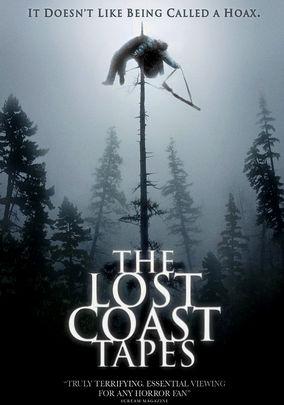A helpful pre-credit scrawl indentifies the Lost Coast area of Northern California as a hotbed of reported Sasquatch activity. You would think a quasi-documentary about the culture of Bigfoot hunters and doubters would be a watchable B movie. But why is it that Bigfoot movies are so bad?
Bigfoot: The Lost Coast Tapes is the second feature-length straight-to-video found footage release in less than a year to tackle what should be ripe material. It has a leg up on Bigfoot County (read my BC review here) in visual quality. While Bigfoot County was filmed on what looks like commercial-grade digital video, Bigfoot: The Lost Coast Tapes, also shot on digital video, has better production values in a field where that is a low bar. Unfortunately, the recent Bigfoot found footage quasi-docs have one more thing in common: obnoxious lead characters.
Sean and Darryl (Drew Rausch and Rich McDonald) are young Los Angeles residents with a plan to document evidence of the existence of Bigfoot. The movie opens as Darryl is walking out of a bank with a fresh $75,000 loan to make his Bigfoot dreams come true.
This opening already poses questions most Bigfoot movies don’t ask. They may not be questions the filmmakers had in mind. Sean and Darryl are clearly the privileged class, who qualify for a substantial loan for a frivolous end: a proposed reality TV show, as if we needed another one. Is there a class divide in Bigfoot culture? The movie does try to have fun with the horror movie tropes of the Stupid White Kids. Sean tries to recruit African-American colleagues to work on his video shoot, but they refuse: “Look at us: we’re light skinned, we aren’t white, we don’t go camping, we don’t roast marshmallows, and we sure aren’t going to chase Bigfoot through the forest!
he frat boy reality TV wannabes seek out a mountain man who claims to own a Bigfoot corpse. Another similarity is the use of an older character actor to play the young investigators’ forest guide. Frank Ashmore, whose credits go back to the Airplane movies and 1970s TV, plays this role in Carl Drybeck. Ashmore has more of a presence than the young charges he leads through the woods, but his character is even less developed than that of his counterpart in Bigfoot County. If the script had given him decent Bigfoot stories to tell by the campfire, Ashmore might have told them with aplomb. But he is not the kind of gifted actor who can get a convincing dramatic reading out of the phone book, and the script, by Brian Kelsey, Bryan O’Cain in their only screenwriting credit, is barely more interesting than that.
In a modern world that clamors for meaning, there is apparently enough clamor to produce Bigfoot movies on a regular basis. If only the quality control for Sasquatchian cinema was as hardy as the myth.

